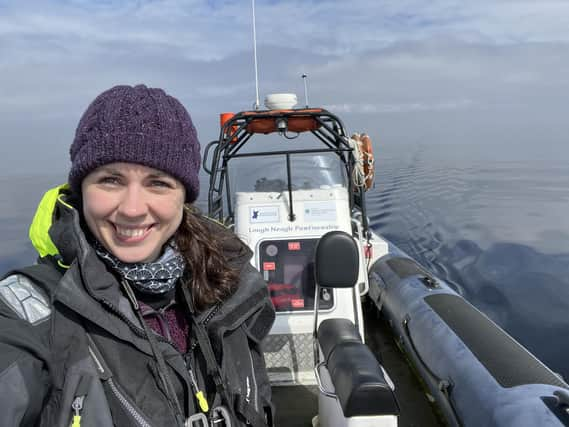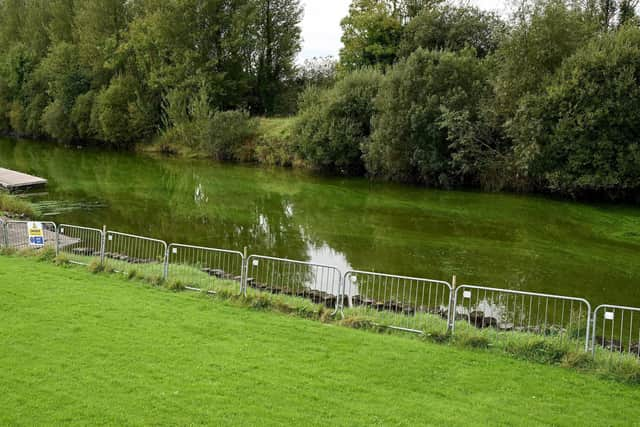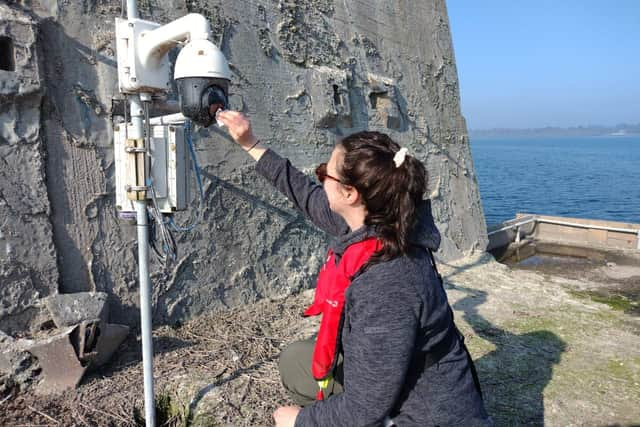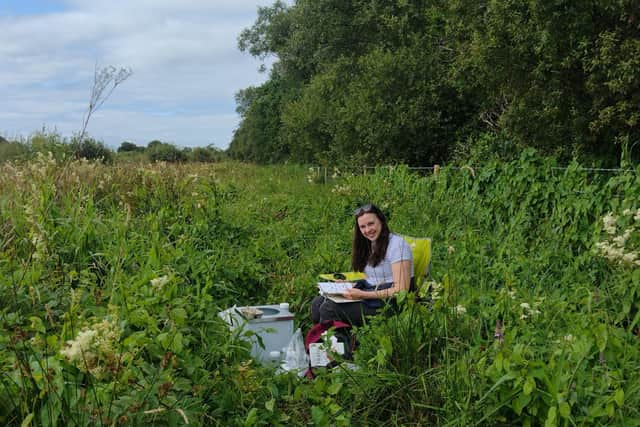Lough Neagh ranger Ciara Laverty: We’re bracing ourselves for another year of the algae


“Back then it would be like walking through a big curtain of flies, it was a real spectacle. You’d swallow them and get them in your hair. But now the summers just aren't the same,” says Ciara, a Lough Neagh ranger.
The flies were long considered a nuisance. On seeing them gather like a plume of smoke above the water, residents would shut their windows and doors to keep the insects out. Now, however, alarm is growing as sightings becoming rarer and rarer.
Advertisement
Hide AdAdvertisement
Hide AdThe Lough Neagh fly isn’t unique. It’s a name given to various chironomid species known as non-biting midges or lake flies, but Ciara explains why it is arguably the most critical part of lake ecology.
"It’s a keystone species. It’s the centre of the food web. It feeds a lot of other species in the Lough Neagh ecosystem. It lives as a little larva at the bottom of the lake. When the fly hatches out as an adult, all of our birds will feed on it and a lot of those are migratory species during the summer, like swifts, swallows, house martins, sand martins, sedge warblers – all the warbler species that come here feed the fly to their young as well."
There could be a number of factors contributing to the drastic decrease in the numbers of these important flies.
“We don't know if it’s because of the water quality or because of the invasive zebra mussel or because the water temperature is a degree warmer now because of the climate. It could be a mixture of all those factors, but I don't think we've seen the impact of the Lough Neagh fly numbers going down yet.”
Advertisement
Hide AdAdvertisement
Hide AdLough Neagh is largest freshwater lake in the UK and Britain, the source of 40 per cent of Northern Ireland’s drinking water. But its accelerating biodiversity crisis was brought into sharp focus last summer when a vast bloom of poisonous blue-green algae blanketed the lake, depriving it of oxygen, choking aquatic life, and even proving fatal to pet dogs and wild birds.


Ciara says a few people have seen the algae again this year.
"The things that have impacted the lough haven't changed. The algae is just pretty much a symptom of what's going on. I think we're going to probably see another algal bloom this summer and maybe over the next few years. Unfortunately with the nutrient overload - that's a problem that's probably been in the making for as long as I've been alive, maybe longer – it's going to take decades to fix.”
It remains unclear whether the algae will be on a par with last year, or, indeed worse.
Advertisement
Hide AdAdvertisement
Hide Ad“I think it will probably depend on the weather,” says Ciara, “but we are bracing ourselves for another summer of the algae. The silver lining is that it has got a lot of attention for Lough Neagh. A lot of the local communities and local people who care about the lough have been protesting and using their voice, so if the algae crisis hits again this summer, I just know that everyone will be up in arms about it and hopefully that will put pressure on politicians to invest in the lough.”


When it comes to water quality, Ciara says everyone has a responsibility because we're all using the system.
“It's not just a Lough Neagh problem, it’s a Northern Ireland-wide problem, because nearly half of the country is in the catchment area of the lough and six main rivers feed into it . We just need be to be mindful of our rivers, but largely I’d like to see changes in farming policy, initiatives to help farmers farm in a more nature-friendly fashion. If you have a septic tank and live in the country in a rural location, I would say get it checked to make sure it's in working order. And I think we need better infrastructure for our waste water as well.”
Ciara, 33, who grew up in the village of Maghery on the southern shore of Lough Neagh and has been a ranger for the last four years, cares passionately about the lough’s wellbeing.
Advertisement
Hide AdAdvertisement
Hide Ad"My great grandfather, who died in the 1950s, was a pollan fisherman on Lough Neagh. It’s nice working on the lough he worked on and wondering what wildlife he was seeing when he was out fishing.”


Ownership of Lough Neagh has a long and contentious history. The aristocratic Shaftesbury family has claimed the lough’s bed, banks and soil since the 19th century. Ciara (and many others) believe it would be better if the lough was brought into public ownership, but says, “a priority at the minute is to actually look at the water quality first and how we as a society are impacting on that.”
She would also like to see tougher sanctions for those polluting the water.
"When you hear of fish kills in rivers, sometimes the penalty doesn't seem like a lot.”
Advertisement
Hide AdAdvertisement
Hide AdCiara, whose office is based at Ballyronan, is out and about all the time visiting the different parts of the 100-mile shoreline and the lough’s islands.
"During the summer a large part of my job is surveying black-headed gulls and common terns on the small islands in the lough. The reason we survey those birds is because they're both amber-listed species, which means their populations have undergone some declines, and they're also a feature species for the lough.
"During the winter we carry out wetland bird surveys along shoreline sites and we try to get some habitat management work done as well.
“In the early spring we’re out counting heron nests at a number of sites around the shoreline. There's never really a downtime, it's always busy, but just in different ways.”
When we speak she’s been up since 6am counting curlews.
Advertisement
Hide AdAdvertisement
Hide Ad"I absolutely love being up at that time in the morning and the wildlife you get to see. I've always loved wildlife and nature, and I always knew that I wanted a career based around that. I feel lucky that I’ve got a job that I love.”
Ciara, who studied Wildlife and Media at the University of Cumbria in England and has a Master's from Queen's in Ecological Management and Conservation Biology, learned a lot about wildlife from her nature-loving late grandfather, Seamus.
“My granda grew strawberries and I used to love getting down the fields with him because I’d be able to wander off and look for birds and frogs.”
That fascination with birds continues as she’s been surveying the southwest corner of the shore of Lough Neagh for curlew nests.
Advertisement
Hide AdAdvertisement
Hide Ad“At the minute, we've got maybe between six and eight pairs of curlews in that area. It's a very small, fragmented breeding population. Everything is pretty much against the curlew. Because they nest on the ground they're really vulnerable to being predated by things like foxes and even crows. They are also contending with habitat loss as well. Hopefully, if we can find some of their nests, we'll try and get a temporary predator fence up around them to keep foxes and badgers out and give the chicks a chance.”
It’s thought there are 150 pairs of curlews in Northern Ireland, but Ciara adds, “This is pretty much the last stronghold of Lough Neagh curlews, so it's kind of a race against time to help that population."
Sadly, over the past 30 years diving duck numbers have also dropped significantly.
"A lot of them would come from northeast Europe and our whooper swans come from Iceland. It’s thought that climate change has impacted them because the areas where they breed aren’t freezing over in the winter so they don't need to fly as far to Lough Neagh.”
Advertisement
Hide AdAdvertisement
Hide AdShe adds: “When my granda was growing up, he said another bird that was around here in large numbers was the corncrake and that it would have kept him awake at night as a wee boy.
"In my childhood the corncrakes just weren’t there, that’s a bird that's pretty much gone extinct here, as a breeding bird. Thinking about that it's sad. My sister's just had a wee baby and I hope curlews are still around for him to enjoy when he's my age.”
Comment Guidelines
National World encourages reader discussion on our stories. User feedback, insights and back-and-forth exchanges add a rich layer of context to reporting. Please review our Community Guidelines before commenting.